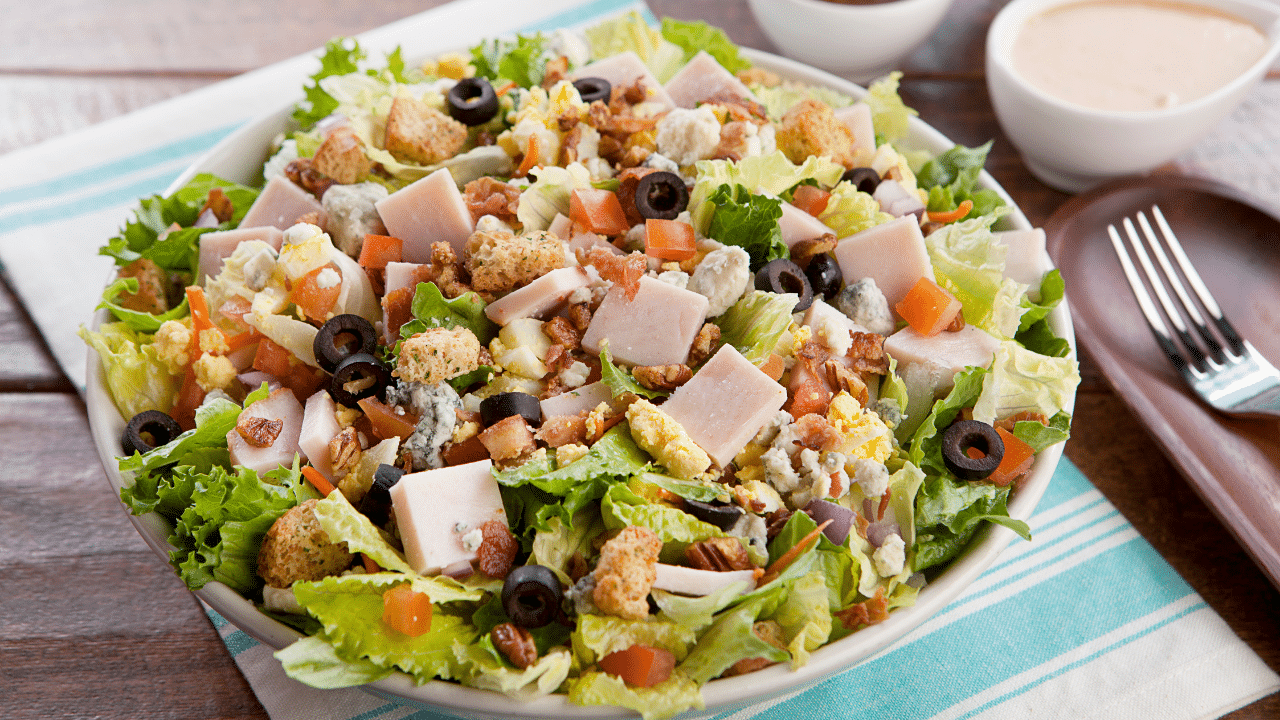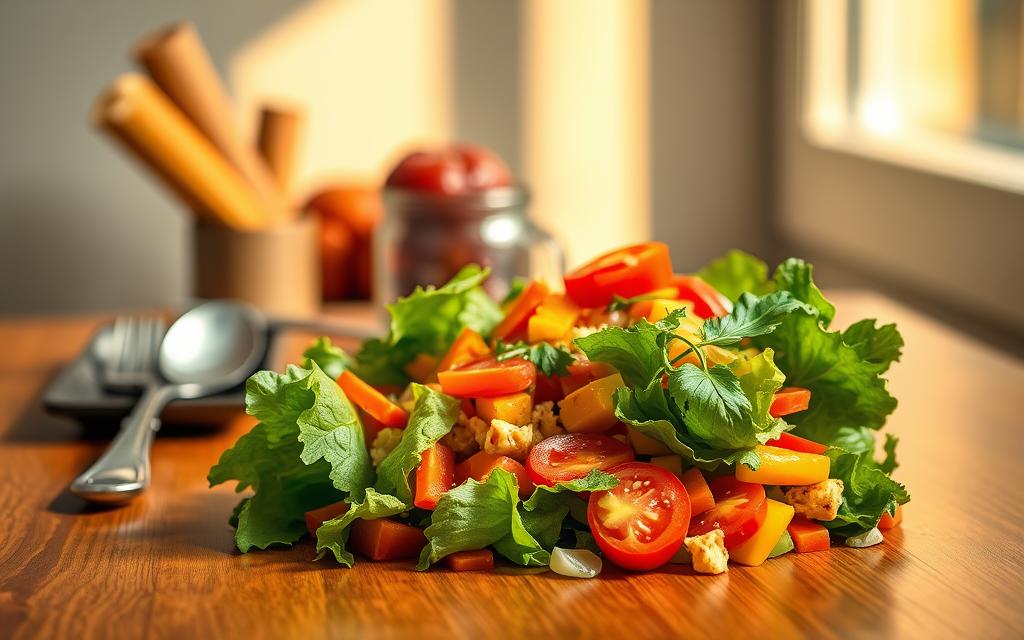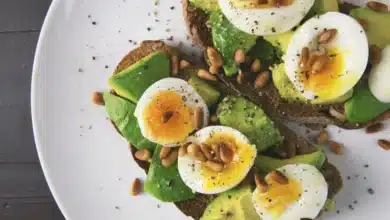Craft a Perfect Salad at Home: Your Guide
Ever wondered why your salads at home don’t taste as good as restaurant ones? Whether you’re a pro in the kitchen or just starting, making the perfect salad is fun and rewarding. This guide will show you how to make a delicious and healthy salad that fits your taste and diet.
Let’s explore the secrets of making a great salad. It should not only fill you up but also make your meals better.
Key Takeaways
- Start with fresh and dry greens for the best texture and taste.
- Incorporate a variety of colorful vegetables for a visually appealing and nutritious salad.
- Adding fruits can bring a delightful sweetness to balance the flavors.
- Enhance your salad with fresh toppings like nuts, seeds, proteins, and cheeses.
- Homemade dressings can elevate the taste while giving you control over the ingredients.
Try these tips to improve your salad-making. Make sure every salad is full of color, flavor, and satisfaction.
Start with Fresh and Dry Greens
Creating a tasty salad begins with picking fresh greens and making sure they’re dry. This prevents your dressing from getting watered down. Fresh and dry greens are the base of a healthy salad. They let other ingredients stand out.
When your greens are dry, your salad tastes better. The dressing sticks to the leaves, adding more flavor to each bite.
Importance of Dry Greens
When making fresh salads, drying your greens is key. Too much water makes the salad soggy. It also causes the dressing to pool at the bottom.
Dry greens ensure your salad has the right texture and taste. This makes every bite enjoyable.
Types of Greens to Use
The greens you choose can change your salad’s flavor and health benefits. Options like romaine, arugula, and baby spinach are popular. Each green has its own taste and health perks.
These greens help you make salads that are tasty and good for you. They add variety to your salad ideas.
| Type of Green | Flavor Profile | Health Benefits |
|---|---|---|
| Romaine | Crisp and Sweet | Rich in Vitamins A and K |
| Arugula | Peppery | High in Folate and Calcium |
| Baby Spinach | Mild and Tender | Loaded with Iron and Fiber |
Choosing the Best Salad Ingredients
Making a healthy and tasty salad starts with picking the right ingredients. The ingredients you choose can make your salad go from good to great. They ensure you get the taste and health benefits you want. Here are some tips to help you choose well.
Incorporate Dark Leafy Greens
Begin with a strong base of dark leafy greens. Kale, spinach, and Swiss chard are great choices. They add flavor and are full of vitamins and minerals. These greens are essential for a nutritious salad.
Colorful Vegetables
Make your salad look and taste better by adding colorful veggies. Bell peppers, carrots, and cherry tomatoes add vibrant colors and nutrients. They make your salad crunchy and fresh, pleasing your eyes and taste buds.
Adding Fruits for Sweetness
Fruits can make your salad sweet and delicious. Try adding apple slices, pear chunks, or citrus segments. They add natural sweetness and extra vitamins and antioxidants.
Fresh Salad Toppings to Enhance Flavor
Adding the right toppings to your salad can change everything. Trying out different ingredients can help you find the perfect mix for your taste. Let’s explore some top picks that can turn your salad into a standout dish.
Nuts and Seeds
Nuts and seeds are great for salads. Almonds and walnuts add a nice crunch and are good for your heart. They also bring healthy fats to the table. Seeds like sunflower and pumpkin offer a similar crunch and add important nutrients.
Protein Choices
Adding protein to your salad makes it more filling and healthy. Grilled chicken is a classic choice that goes well with many dressings and veggies. Tofu is a great option for vegetarians, offering a meaty texture and soaking up flavors. Beans are also excellent for vegetarians, providing fiber and protein.
Cheese Varieties
Cheese is a must-have for salad toppings. Feta, goat, and shaved Parmesan each add a unique taste and creamy texture. Cheese adds richness and a touch of saltiness to your salad.
Combining nuts, proteins, and cheese creates a perfect mix of textures and tastes. By choosing your toppings wisely, you can elevate a simple salad into a gourmet delight that excites your senses.
| Fresh Salad Toppings | Benefits |
|---|---|
| Nuts (Almonds, Walnuts) | Crisp texture, healthy fats, heart-healthy |
| Seeds (Sunflower, Pumpkin) | Crunchy texture, nutrient-rich |
| Grilled Chicken | Protein-rich, enhances fullness |
| Tofu | Vegetarian protein, versatile |
| Beans | Fiber and protein, hearty |
| Cheese (Feta, Goat, Parmesan) | Creamy, adds richness and flavor balance |
How to Make a Nice Salad?
Making a great salad starts with fresh, crisp greens. Choose from romaine lettuce, arugula, or butterhead lettuce. Make sure they’re clean and dry to keep them crunchy.
Then, add colorful veggies and fruits. Use vibrant peppers, juicy tomatoes, and crisp cucumbers. Add fresh berries, apple slices, or mandarin segments for sweetness.
Don’t forget to add proteins for more substance. Grilled chicken, seared tofu, or boiled eggs are great. Also, mix different cheeses like feta or blue cheese for extra flavor and creaminess.
Finish with nuts or seeds for crunch and fresh herbs like basil or dill for a burst of flavor.
The dressing is key to tying everything together. A light vinaigrette adds zest, while creamy dressings from yogurt or avocado offer a smooth contrast.
Learning to make a nice salad is all about creativity and versatility. With the right ingredients and dressings, you’ll make salads that taste great and look good too. They’ll satisfy your taste buds and meet your nutritional needs.
Making Homemade Salad Dressing
Creating your own salad dressing lets you explore new flavors. You can make it just how you like it, whether it’s a classic vinaigrette or a creamy delight. There’s something for everyone.
Classic Vinaigrette
The classic vinaigrette is simple yet amazing. Mix high-quality olive oil with vinegar in a 3:1 ratio. Add mustard for a tangy taste, honey for sweetness, and pepper for a kick. Your homemade dressing will make any salad taste better.
Creamy Dressings
Creamy dressings add a rich touch to salads. Caesar and ranch are favorites. They mix mayonnaise, garlic, lemon juice, and anchovies for Caesar. Ranch uses buttermilk and herbs. These dressings give a smooth texture that goes well with crunchy veggies.
Non-fat Options
For a healthier choice, try non-fat salad dressings. Yogurt-based dressings use Greek yogurt, lemon juice, and herbs. They’re tangy yet creamy. Or, mix citrus juice with a bit of mustard and honey for a light, zesty dressing.
Seasoning Your Salad
Seasoning your salad right can make it go from good to great. Start with balanced salts and freshly ground pepper. This brings out the natural flavors of your ingredients.
Adding fresh herbs and spices can make your salad even better. It adds complexity and depth, making each bite a joy.
Salts and Peppers
The right salts and peppers are key when seasoning your salad. Choose salts like sea salt or Himalayan pink salt for a unique taste. Freshly ground black pepper adds a nice kick, enhancing the greens and other ingredients.
| Type | Flavor Profile | Best Usage |
|---|---|---|
| Sea Salt | Clean, crisp | All-purpose, finishing |
| Himalayan Pink Salt | Rich, mineral | Finishing, mild seasoning |
| Black Pepper | Bold, slightly spicy | All-purpose |
| White Pepper | Mild, earthy | Light-colored dishes |
Herbs and Spices
Adding fresh herbs and spices is a top tip for a healthy salad. Use herbs like basil, mint, or cilantro for a fresh taste. Spices like sumac add a lemony zest, while paprika brings a smoky flavor.
Quick Salad Ideas for Busy Days
When time is tight, quick salad ideas can be a big help. These easy salads are both healthy and simple to make. They let you stay on track with your diet, even when you’re busy.
Simple Salad Combinations
Creating quick salads is easier with simple mixes. Try combining fresh greens, cherry tomatoes, sliced cucumbers, and balsamic vinaigrette for a tasty meal. Or, mix arugula with parmesan, sliced pears, and lemon dressing for a unique flavor.
Prepping Ingredients in Advance
Getting ready ahead of time is crucial for quick salads. Keep chopped veggies, grilled chicken or tofu, and basic dressings ready. This way, you can quickly create healthy salads, even on the most hectic days.
Best Dressing for Salads
Choosing the right dressing can make your salad recipe shine. It’s key to pick a dressing that fits your salad’s type. For light salads, citrus-based dressings are great. They add a zesty flavor without overpowering the greens.
For salads with big ingredients like chicken or steak, creamy dressings are better. They bring a richer taste that complements the ingredients well. This balances the flavors in your salad.
Here’s a quick guide to help you choose the best dressing for your salads:
| Salad Type | Recommended Dressing |
|---|---|
| Light Greens | Citrus-based Vinaigrette |
| Mixed Greens with Vegetables | Balsamic Vinaigrette |
| Hearty Proteins (Chicken, Steak) | Caesar Dressing |
| Fruit Salads | Honey Mustard Dressing |
| Grain Bowls | Tahini Dressing |
In conclusion, the right dressing for salads depends on your ingredients and taste. Try out different dressings to find your favorite. And don’t be shy to get creative!
Assembling Your Salad
Assembling your salad is key to a perfect dish. The order of layering is important for balance and flavor. It keeps the salad looking good and each part in its best shape.
Layering Ingredients
Start with carrots and cucumbers at the bottom. They can handle the weight of other ingredients. Then, add your greens like lettuce, spinach, or arugula.
Next, add proteins like grilled chicken, tofu, or beans. This spreads them out evenly. Finally, add small toppings like seeds, nuts, and dried fruits for texture and flavor.
Tossing Techniques
Learning how to toss your salad is crucial. Use a big bowl and a gentle touch. This way, the dressing and seasonings spread out right without hurting the greens.
Toss from the bottom up. This keeps the salad’s texture and looks good. It makes sure everything is mixed well and stays crunchy.
Conclusion
Making the perfect salad at home is all about quality ingredients and knowing how flavors work together. Start with fresh greens and add colorful veggies and fruits. This makes every bite full of life and health.
Add nuts, seeds, cheeses, and proteins to your salad for extra flavor. A good dressing is key, whether it’s a vinaigrette or something creamy. Season with salts, peppers, herbs, and spices to enhance each ingredient’s taste.
Using these tips can make salad-making a fun experience. It turns a simple side into a main attraction. Be creative and enjoy making your own delicious salads.
FAQ
How do I start with fresh and dry greens for my salad?
First, wash your greens well to get rid of dirt and pesticides. Then, dry them using a salad spinner or a clean towel. This prevents the dressing from making the salad soggy. Dry greens also help the dressing stick better, making each bite tasty.
What types of greens are best for a salad base?
Great greens for salads include romaine, arugula, and baby spinach. Each adds its own taste and nutrients. Romaine is crisp, arugula is peppery, and baby spinach is mild.
For a nutrient-rich base, try dark leafy greens like kale, spinach, or Swiss chard.
What healthy salad ingredients should I include?
To make a healthy salad, add colorful veggies like bell peppers and carrots. Fruits like apples, pears, or citrus segments add sweetness. These ingredients make your salad look good and boost its nutrition.
What are some fresh salad toppings to enhance flavor and texture?
For extra flavor and crunch, add nuts (almonds, walnuts) and seeds (sunflower, pumpkin). Proteins like grilled chicken, tofu, or beans make the salad filling. Cheese, like feta, goat, or shaved Parmesan, adds creamy texture and flavor.
How can I make a nice salad at home?
Begin with fresh greens, add colorful veggies and fruits, and mix in protein for fullness. Top it with a tasty dressing that matches the flavors. Mixing different textures and tastes makes your salad better. Keep pre-chopped veggies and proteins ready for easy salad making.
How can I make homemade salad dressing?
Making your own dressing lets you customize and keep it fresh. A simple vinaigrette uses olive oil, vinegar, and maybe mustard and honey. For creamier dressings, try Caesar or ranch. Healthy options include non-fat yogurt or citrus juice dressings.
How should I season my salad for the best flavor?
Seasoning is key to a great salad. Use salt and freshly ground pepper to bring out the natural tastes. Fresh herbs like basil, mint, and cilantro, along with spices like sumac or paprika, add depth and complexity.
What are some quick salad ideas for busy days?
For quick salads, have pre-chopped veggies, proteins, and dressings ready. Simple combos include greens with cherry tomatoes, cucumbers, and balsamic vinaigrette or arugula with Parmesan, pears, and lemon dressing. Preparing ahead ensures healthy options are always ready.
What is the best dressing for salads?
The right dressing depends on your salad and taste. Light salads do well with citrus dressings for a zesty taste. Heavier salads with proteins might need creamy or robust dressings to balance the flavors.
How do I assemble my salad for optimal enjoyment?
Start with sturdy ingredients like carrots and cucumbers at the bottom. Add greens, proteins, and small toppings like seeds and nuts next. Toss well to spread dressing and seasonings evenly, keeping delicate ingredients intact.




